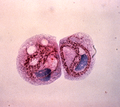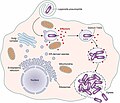Legionella pneumophila
Legionella pneumophila is a thin, aerobic, pleomorphic, flagellated, non-spore-forming, Gram-negative bacterium of the genus Legionella. It is the primary human pathogenic bacterium in this group and is the causative agent of Legionnaires' disease, also known as legionellosis.
Characteristics[edit]
Legionella pneumophila, like all Legionella species, is found in fresh water environments, such as lakes and streams. It can survive in a wide range of temperatures, but prefers temperatures between 25 and 45 degrees Celsius, with an optimum around 35 degrees Celsius. This makes it an ideal inhabitant of hot water systems, such as those found in large buildings, hotels, and hospitals.
Pathogenesis[edit]
Legionella pneumophila is a facultative intracellular parasite that can invade and replicate inside amoebae in the environment. This provides a training ground for invasion and replication in alveolar macrophages in the lung when inhaled. The bacteria use a secretion system to inject effector proteins into the host. These effectors modulate host cell functions to provide a replicative niche for the bacteria.
Diagnosis and Treatment[edit]
Diagnosis of Legionella pneumophila infection can be challenging, as it requires specific tests not commonly performed on patients with pneumonia. The most commonly used diagnostic method is the urinary antigen test, which detects the presence of Legionella antigen in the urine. Treatment typically involves antibiotics such as macrolides or quinolones.
Prevention[edit]
Prevention of Legionella pneumophila infection involves regular maintenance and disinfection of water systems, particularly in settings where the bacteria are likely to proliferate, such as hospitals and hotels. This can include heat treatment, chlorination, or the use of biocides.
See Also[edit]
Legionella_pneumophila[edit]
-
T. pyriformis hosting L. pneumophila
-
The life cycle of Legionella pneumophila within eukaryotic host cells
-
Legionella pneumonia
-
TEM image of Legionella pneumophila within a phagocytic cell
Ad. Transform your life with W8MD's Budget GLP-1 injections from $75


W8MD offers a medical weight loss program to lose weight in Philadelphia. Our physician-supervised medical weight loss provides:
- Weight loss injections in NYC (generic and brand names):
- Zepbound / Mounjaro, Wegovy / Ozempic, Saxenda
- Most insurances accepted or discounted self-pay rates. We will obtain insurance prior authorizations if needed.
- Generic GLP1 weight loss injections from $75 for the starting dose.
- Also offer prescription weight loss medications including Phentermine, Qsymia, Diethylpropion, Contrave etc.
NYC weight loss doctor appointmentsNYC weight loss doctor appointments
Start your NYC weight loss journey today at our NYC medical weight loss and Philadelphia medical weight loss clinics.
- Call 718-946-5500 to lose weight in NYC or for medical weight loss in Philadelphia 215-676-2334.
- Tags:NYC medical weight loss, Philadelphia lose weight Zepbound NYC, Budget GLP1 weight loss injections, Wegovy Philadelphia, Wegovy NYC, Philadelphia medical weight loss, Brookly weight loss and Wegovy NYC
|
WikiMD's Wellness Encyclopedia |
| Let Food Be Thy Medicine Medicine Thy Food - Hippocrates |
Medical Disclaimer: WikiMD is not a substitute for professional medical advice. The information on WikiMD is provided as an information resource only, may be incorrect, outdated or misleading, and is not to be used or relied on for any diagnostic or treatment purposes. Please consult your health care provider before making any healthcare decisions or for guidance about a specific medical condition. WikiMD expressly disclaims responsibility, and shall have no liability, for any damages, loss, injury, or liability whatsoever suffered as a result of your reliance on the information contained in this site. By visiting this site you agree to the foregoing terms and conditions, which may from time to time be changed or supplemented by WikiMD. If you do not agree to the foregoing terms and conditions, you should not enter or use this site. See full disclaimer.
Credits:Most images are courtesy of Wikimedia commons, and templates, categories Wikipedia, licensed under CC BY SA or similar.
Translate this page: - East Asian
中文,
日本,
한국어,
South Asian
हिन्दी,
தமிழ்,
తెలుగు,
Urdu,
ಕನ್ನಡ,
Southeast Asian
Indonesian,
Vietnamese,
Thai,
မြန်မာဘာသာ,
বাংলা
European
español,
Deutsch,
français,
Greek,
português do Brasil,
polski,
română,
русский,
Nederlands,
norsk,
svenska,
suomi,
Italian
Middle Eastern & African
عربى,
Turkish,
Persian,
Hebrew,
Afrikaans,
isiZulu,
Kiswahili,
Other
Bulgarian,
Hungarian,
Czech,
Swedish,
മലയാളം,
मराठी,
ਪੰਜਾਬੀ,
ગુજરાતી,
Portuguese,
Ukrainian





